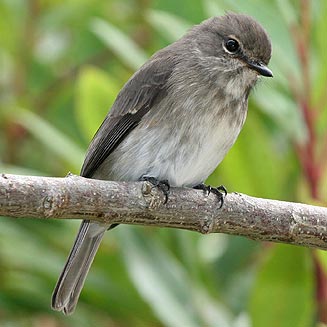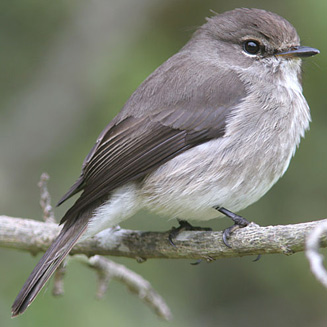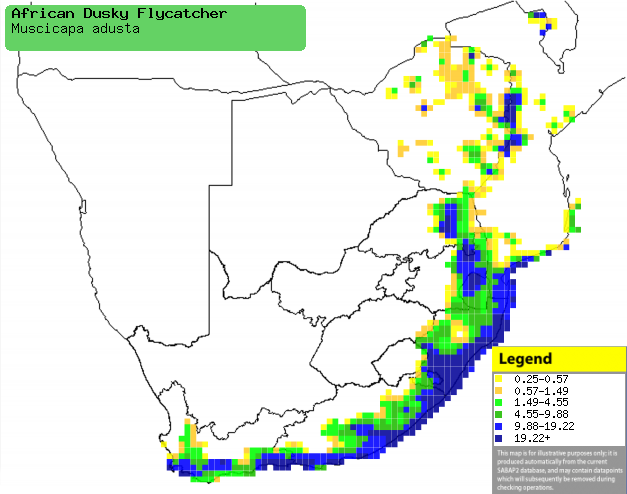|
Muscicapa adusta (African dusky
flycatcher)
DonkervlieŽvanger [Afrikaans];
Unomaphelana [Xhosa]; Kaapse vliegenvanger [Dutch]; Gobemouche sombre
[French]; Dunkelschnšpper [German]; Papa-moscas-sombrio [Portuguese]
Life
> Eukaryotes >
Opisthokonta
> Metazoa (animals) >
Bilateria >
Deuterostomia > Chordata >
Craniata > Vertebrata (vertebrates) > Gnathostomata (jawed
vertebrates) > Teleostomi (teleost fish) > Osteichthyes (bony fish) > Class:
Sarcopterygii (lobe-finned
fish) > Stegocephalia (terrestrial
vertebrates) > Tetrapoda
(four-legged vertebrates) > Reptiliomorpha > Amniota >
Reptilia (reptiles) >
Romeriida > Diapsida > Archosauromorpha > Archosauria >
Dinosauria
(dinosaurs) > Saurischia > Theropoda (bipedal predatory dinosaurs) >
Coelurosauria > Maniraptora > Aves
(birds) > Order: Passeriformes
> Family: Muscicapidae > Genus: Muscicapa
 |
 |
|
African dusky flycatcher, Harold Porter Botanical
Gardens, Western Cape, South Africa. [photo
Duncan Robertson ©] |
African dusky flycatcher, Kirstenbosch Botanical
Gardens, South Africa. [photo Trevor Hardaker ©] |
Distribution and habitat
Although it has in isolated population in Cameroon, the
bulk of its distribution lies from Ethiopia through Kenya and Tanzania to
Zambia, southern DRC and southern Africa. Here it is common in South Africa,
Mozambique and Swaziland, with a more scarce population in Zimbabwe (although
common in the eastern highlands). It generally prefers fairly dense evergreen
vegetation, such as clearings and edges of Afromontane and coastal lowland
forest, gardens and parks, but also occurring in valley bushveld and floodplain
woodland along the Zambezi River. It occasionally occupies miombo (Brachystegia
and alien tree strands with Eucalyptus, pines (Pinus), and wattles
(Acacia), especially on the border with fynbos.
|
 |
|
Distribution of African dusky flycatcher in southern Africa,
based on statistical smoothing of the records from first SA Bird Atlas
Project (©
Animal Demography unit, University of
Cape Town; smoothing by Birgit Erni and Francesca Little). Colours range
from dark blue (most common) through to yellow (least common).
See here for the latest distribution
from the SABAP2. |
Predators and parasites
It has been recorded as prey of
Accipiter rufiventris
(Rufous-chested sparrowhawk) in the Western Cape.
Brood parasites
It has been recorded as host of the
following birds:
Movements and migrations
Resident in Zimbabwe but partially migratory in
South Africa, with birds moving east in Winter.
Food
It mainly eats small flying insects, doing most of its
foraging from a low branch, from which it hawks prey aerially and occasionally
pounces on insects on the ground. It sometimes joins mixed-species foraging
flocks, also using sheep and Bushbuck (Tragephalus scriptus) as perches,
catching the insects they flush while moving around. The following food items have been recorded
in its diet:
- Insects
- Coleoptera
(beetles)
- syrphid wasps
- midges
- noctuid moths and their caterpillars
- aphids
- Fruit
- Vepris lanceolata (White-ironwood)
- Morus (mulberries)
Breeding
- Both sexes construct the nest in up to 22 days, consisting of an untidy
open cup, usually built of dead leaves, moss, grass, lichens, creepe
tendrils, feathers and spider web and lined with more fine material,
although it can be made entirely out of moss. It is typically placed in a
cavity, such as in a pipe, behind peeling bark, in a rock crevice, among
driftwood, in a dead tree stump or between the rafters of a thatched roof.
It may use the nest of another bird, such as a
Red-winged starling,
barbet,
Cape Weaver or a
Cape canary.
- Egg-laying season is from September-January, peaking from
October-November.
- It lays 2-3 eggs, which are incubated solely by the female for about
14-15 days, all the while fed by the male at the nest.
- The chicks are mainly brooded by the female but fed by both sexes,
leaving the nest after about 17, rarely 22 days. It usually rears two broods
per breeding season, meaning that fledglings often leave after only 5 more
days, so that the female can lay the next egg clutch.
Threats
Not threatened.
References
-
Hockey PAR, Dean WRJ and Ryan PG 2005. Roberts
- Birds of southern Africa, VIIth ed. The Trustees of the John Voelcker
Bird Book Fund, Cape Town.
|
